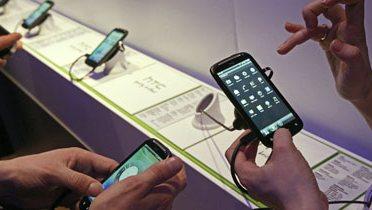Editor’s Note: In testimony at the U.S. House Subcommittee on Healthcare and Technology hearing on “
Broadband: A Catalyst for Small Business Growth
,” Darrell West argues that broadband access is a crucial driver of job creation and economic growth.
FULL TEXT OF THE TESTIMONY:
Chairwoman Ellmers, Ranking Member Richmond, and members of the Subcommittee. Thank you for the opportunity to testify at this hearing on “Broadband: A Catalyst for Small Business Growth.”
Since 2008, I have been Vice President and Director of Governance Studies and Director of the Center for Technology Innovation at the Brookings Institution. I am the author of 18 books, including Digital Government: Technology and Public Sector Performance (Princeton University Press, 2005), Digital Medicine: Health Care in the Internet Era (Brookings Institution Press, 2009) and Digital Schools: How Technology Can Transform Education (forthcoming, Brookings Institution Press, 2012). As the remarks below document, broadband plays an important role in furthering economic development opportunities for small businesses, especially in rural areas.
The Crucial Role of Broadband in Economic Development
Broadband is a crucial driver of job creation and economic growth. Researchers have found a link between technology innovation and overall economic prosperity. For example, a World Bank study of 120 nations between 1980 and 2006 undertaken by Christine Qiang found that each 10 percentage point increase in broadband penetration adds 1.3 percent to a country’s gross domestic product.[1] Investments in this area creates jobs and lays the groundwork for long-term development.
The applications enabled by the Internet are especially important for small businesses and rural communities because they have become crucial platforms for innovation in health care, education, entrepreneurship, and communications. High-speed, universal broadband furthers productivity and generates powerful new efficiencies and economies of scale. According to Philip Bond, the president of TechAmerica, “each tech job supports three jobs in other sectors of the economy.” And in information technology, he says, there are five jobs for each IT position.[2]
Fast broadband and wireless speeds help people take advantage of new digital tools such as telemedicine, video on demand, GIS mapping, and video conferencing. New developments in health information technology and mobile health, such as emailing X-rays and other medical tests, require high-speed broadband. Distance learning requires sufficient bandwidth to connect students across geographic areas.[3]
Strategies for Broadband Innovation
Right now, the United States does not have a coherent strategy for broadband innovation. Unlike other nations, we make policy in a piecemeal fashion and focus on short rather than long-term objectives. This limits the efficiency and effectiveness of our efforts.
Promoting Entrepreneurship and Small Business: Entrepreneurs play a major role in the economies of many countries. They launch companies, build businesses, and provide jobs. Increasingly, as the globe moves towards a digital economy, small business developers require mobile technology to develop their companies. Broadband allows them to stay connected even while they are on the go. They can reach bank officers, suppliers, and customers as they travel around the area. This helps them remain in close contact and build the required relationships.[4]
Due to their relatively low cost and ubiquitous connections, mobile devices and cellphones help overcome digital disparities. There are well-established inequities based on race and ethnicity in socio-economic well-being.
Yet mobile devices have narrowed the gap in technology utilization. Smartphone ownership actually is higher among Hispanics (45 percent) and African-Americans (33 percent) than whites (27 percent).[5] This helps minorities start businesses, access m-health applications, engage in m-learning, and gain the full benefits of the technology revolution.
Technology offers important assistance for those in under-served rural communities. People living in rural areas suffer from limited access to broadband and Internet services. This makes it difficult for them to participate in the digital economy. Investing in digital infrastructure represents a way to improve Internet access in places that are geographically remote.
Improving Health Care: Wireless and broadband technologies represent key ingredients in providing quality and accessible care, and gaining budgetary efficiencies. Health care based on mobile health, remote monitors, electronic medical records, social networking sites, video conferencing, and Internet-based recordkeeping makes a positive difference for many people. For example, we should encourage email reminders to take medicine, mechanisms to measure satisfaction with doctors and hospitals, and websites that make care ratings publicly available to other patients.
One of the virtues of e-health is that it puts the patient in charge of certain activities. Using remote monitoring devices, people can measure their own weight, blood pressure, pulse, and sugar levels, and send test results electronically to health care providers. They get personalized feedback via email and reminders when they gain weight, have an uptick in their cholesterol levels, don’t take their medicine, or have high blood pressure. Social networking sites provide discussion forums and the benefit of collective experience from other people suffering similar problems. With these tools, patients take responsibility for their routine health care and rely on physicians for more serious medical conditions.
National surveys show that Americans would like to employ digital technologies in their medical care. For example, 77 percent said they would like to get reminders via email from their doctors when they are due for a visit, 75 percent want the ability to schedule a doctor’s visit via the Internet, 74 percent would like to use email to communicate directly with their doctor, 67 percent would like to receive the results of diagnostic tests via email, 64 percent want access to an electronic medical record to capture information, and 57 percent would like to use a home monitoring device that allows them to email blood pressure readings to their doctor.[6]
The sophistication of mobile devices has spawned a variety of new medical applications that help doctors and patients stay in touch and monitor health care needs. For example, mobile applications allow physicians to get test results on their mobile device. They can look at blood pressure records over time, see an electro-cardiogram, or monitor a fetal heart rate.
These applications make doctors more efficient because they don’t have to be in the physical presence of a patient to judge his or her condition. Digital technology allows people to overcome the limitations of geography in health care and access information at a distance. This makes it possible for patients to get a second opinion without visiting another physician by sending that person relevant medical tests. If a personal conference is required, doctors can use video conferencing to speak to individuals located in another city or state.
Advancing Educational Achievement and Access: Broadband helps to personalize learning and improve student assessment.[7] Speaking at a recent education policy symposium, Mark Schneiderman, the senior director of education policy for the Software & Information Industry Association, said that “the factory model that we’ve used to meet the needs of the average student in a mass production way for years is no longer meeting the needs of each student”. Instead, he called for education changes that would recognize the enormity of the information changes that have taken place in American society. In today’s world, he claims students “are surrounded by a personalized and engaging world outside of the school, but they’re unplugging not only their technology, but their minds and their passions too often, when they enter into our schools.”[8]
Wired classrooms, handheld devices, and electronic instructional sets let pupils learn at their own pace and in their own manner. Personalization makes education more adaptive and timely from the student standpoint and increases the odds of pupil engagement and mastery of important concepts. It frees teachers from routine tasks and gives them more time to serve as instructional coaches and mentors for students.[9]
Smartphones and mobile devices are being utilized for educational purposes in a variety of institutions. An analysis of application stores for Blackberry, the iPhone, and Android found that popular education-oriented downloads included My Very First App, Star Walk, Ace Flashcard, Wheels on the Bus, and Cosmic Discoveries. There also were a number of “productivity-enhancing” apps in the areas of administration, data collection, and collaboration.[10]
Some teachers have developed Facebook applications for personalized learning. They are using social media to post comments, get reactions from students, set up meetings, and express views about the class. Research conducted at a private liberal arts university found that for courses set up in this manner, students averaged an hour per day accessing the Facebook Learning Management System. Instructors discovered that students responded almost immediately to messages about the course and that pupils “engaged more in questioning through Facebook messages directed to the instructor than asking them verbally in the face-to-face classroom”.[11]
Professor Chris Dede of Harvard University has looked at “immersive interfaces” enabled by m-learning and found three educational advantages: allowing multiple perspectives, situated learning, and transferring knowledge from one setting to another.[12] Each of these experiences enhances the learning process and allows students to gain new knowledge or apply insights to different areas.
Handheld devices enhance student learning in other ways as well. They have been found to bridge the gap between haves and have-nots, and expose pupils to a rich array of instructional resources. Students find this approach very engaging and report great satisfaction with mobile learning approaches. This is particularly the case with underserved populations located in rural or poor districts.[13]
Building the Mobile Economy: Consumers like the convenience of mobile broadband. They enjoy being able to access email, the Internet, and a wide range of applications online. People no longer are tied to the home or office for social, economic, or civic engagement. They can access information and complete transactions wherever they happen to be.
For the first time in history, the trend lines for installed smartphones and personal computers will cross at the end of 2012.[14] The total number of IP-network enabled desktops, notebooks, and netbook personal computers now exceeds that of cellular phones with a high level operating system. However, due to the high growth rate in consumer and business installations of smartphones, mobile devices will outnumber personal computers this year. Smartphone installation currently is growing at about three times the rate of personal computers.
The extraordinary growth rate in mobile broadband adoption means that within four years, mobile broadband will comprise about 80 percent of total broadband subscriptions and become the dominant means of Internet connectivity. In emerging markets, mobile broadband is expected to increase from 37 to 79 percent of all broadband subscriptions between 2010 and 2015.
In the United States, a survey undertaken by the Pew Research Center this year found that 83 percent of American adults own a cellphone, while 35 percent own a smartphone.[15] When asked whether they used various services, smartphone owners indicated that they employed it to send or receive text messages (92 percent), take a picture (92 percent), or access the Internet (84 percent).
Needed Policy Actions
Broadband utilization and mobile technology innovation is growing, but there remain several actions that would further economic development. Below, I review specific actions that will help small business take advantage of digital innovation.[16]
Extend and Make Permanent Research and Development Tax Credits: One example of our national short-sightedness is the research and development tax credit. Members of Congress have extended this many times in recent years, but they generally do this on an annual basis. Rather than extend this credit over a long period of time, they renew it episodically and never on a predictable schedule.
Due to political uncertainties and institutional politics, we end up creating inefficiencies linked to the vagaries of federal policymaking. While companies in other countries invest and deduct on a more predictable schedule, we shoot ourselves in the foot through a short-sighted perspective. Many other countries offer more favorable tax policies than is the case in United States. We should extend and make permanent the R and D tax credit so that telecommunications companies, Internet service providers, and small businesses have greater certainty about tax policy.
Approve Reasonable Universal Service Fund Reform for Broadband Deployment: Our current Universal Service Fund (USF) dates back to 1997, when the Internet was in its infancy, and there were little social media or few mobile devices. We need to update our policies so that small businesses and consumers can take advantage of 21st century digital tools.
The world has shifted from a communications model based on telephones and mail to a digital economy that relies on the Internet, mobile phones, e-commece, and social media. Businesses find customers through digital communications and consumers now can place phone calls via Google Voice or Skype.
At the same time, many Americans have smartphones that serve both as telephones and Internet providers. People can browse the Web, place phone calls, and access email through a single device. They can do this while on the run and wherever they happen to be.
Yet the billions generated for the USF continue to focus almost exclusively on phone services. Its four programs (E-Rate, High-Cost, Low Income, and Rural Health Care) provide subsidies for schools and libraries, infrastructure developers, low income people, and health providers, respectively. As noted by George Washington University Law Professor and Brookings Non-Resident Senior Fellow Jeffrey Rosen, these programs are inefficient, expensive, and redundant in what they provide. In his USF study, he cites examples of a “Hawaiian company [that] is paid $13,345 per year per telephone line for terrestrial service even though satellite telephone service is available for about one-tenth of that price” and the Mississippi community of Hattiesburg that “is served by twelve carriers, each receiving High Cost program subsidies.”[17]
We should update the Universal Service Fund to allow those living in under-served communities to use fees paid into the High Cost Program and the Low Income Program to cover voice and broadband services. About 30 percent of Americans remain outside the Internet revolution. They are at a serious disadvantage when communicating with friends and family members, forming businesses, accessing mobile health, or taking distance learning courses.
To help them, we should phase out the High Cost Fund and replace it with a Mobility Fund and a Connect America Fund, as proposed by the Federal Communications Commission. According to Rosen, the former proposal would “support the development of mobile broadband infrastructure into those few areas where 3G coverage is unavailable,” while the latter would “enable all U.S. households to access a network that is capable of providing both high-quality voice-grade service and broadband”.[18] This redeployment of federal resources within a market framework would promote better service for consumers and small businesses.
Use Incentive Auctions to Reallocate Scarce Spectrum: We are dangerously short of spectrum for wireless and broadband expansion. According to the Federal Communications Commission, we need a minimum of 300 MHZ over the next five years in order to accommodate growing cellphone usage, handheld devices, smartphones, tablets, and mobile broadband. It is vital for consumers and small businesses to gain access to spectrum in order to facilitate job creation, economic development, and entrepreneurship.
A market-based mechanism for reallocating scarce resources is spectrum auctions.[19] Used successfully in the past, members of Congress should approve incentive auctions that would allow companies that no longer need spectrum to sell them to other businesses willing to pay. This approach would have several benefits. It would provide a way for companies to sell unused resources. It gives access to spectrum for cell and mobile providers so they better can serve consumers and businesses. Auctions also bring in needed resources to the federal government to finance the national budget.
We also need to determine ways to make more efficient use of existing spectrum. In a Brookings paper, Robert Matheson and Adele Morris propose technical solutions designed to improve the efficiency of spectrum utilization. They argue that it is possible to utilize current bandwidth through a combination of legal, regulatory, policy, and technical improvements. For example, they suggest that licensees should be able to “buy, sell, aggregate, and subdivide their LERs (licensed electrospace right) at will.”[20] A “flexible rights regime” offers greater efficiency, they say, than a command and control approach.
Increase Broadband Adoption: With nearly one-third of Americans outside the Internet Revolution, it is important to expand broadband adoption. There are many reasons why people have not adopted broadband service. A national survey undertaken by the Federal Communications Commission reveals that 36 percent cite the overall cost of the service, 22 percent say they are uncomfortable
These results suggest a variety of actions that would increase broadband adoption. For example, digital literacy programs would train people on online applications that may be useful to them. Improved market competition also would help drive down consumer cost barriers that currently limit use. And outreach programs could help bridge the digital divide based on age, race, gender, income, and education.
Unless we boost adoption levels, it will be difficult to gain the economies of scale enabled by digital technology. With the proposed actions, consumers and small businesses would have a fairer opportunity to compete and gain the benefits of the new digital economy.
Notes
[1] Christine Zhen-Wei Qiang, “Telecommunications and Economic Growth,” Washington, D.C.: World
Bank, 2009.
[2] Philip Bond, “Tech Provides Map for Nation’s Future,” Politico, September 18, 2011.
[3] Taken from Darrell M. West, “Technology and the Innovation Economy,” Washington, D.C.: Brookings Institution Center for Technology Innovation, October 19, 2011.
[4] For a more extended treatment of this topic, see Darrell M. West, “Ten Facts About Mobile Broadband,” Washington, D.C.: Brookings Institution Center for Technology Innovation, December 8, 2011.
[5] Deloitte, “The Impact of 4G Technology on Commercial Interactions, Economic Growth, and U.S. Competitiveness,” August, 2011, p. 14.
[6] Darrell M. West, The Next Wave: Using Digital Technology to Further Social and Political Innovation,” Washington, D.C.: Brookings Institution Press, 2011.
[7] Darrell M. West, Digital Schools: How Technology Can Transform Education,” Washington, D.C.: Brookings Institution Press, forthcoming, 2012.
[8] Innovate to Educate, “System [Re]Design for Personalized Learning,” Washington, D.C.: Software & Information Industry Association, 2010, p. 8.
[9] Ruth Moody and Michael Bobic, “Teaching the Net Generation without Leaving the Rest of Us Behind: How Technology in the Classroom Influences Student Composition,” Politics & Policy, Volume 39, no. 2, 2011, pp. 169-194.
[10] Jessica Briskin, Tutaleni Asino, Michael Montalto-Rook, and Yaozu Dong, “Smart Apps: An Analysis of Educational Applications Available on Smartphones and the Implications for Mobile Learning,” paper presented at the annual convention of the Association for Educational Communications and Technology, Anaheim, California, 2010.
[11] Stephoni Case and Susan Stansberry, “Teaching with Facebook as a Learning Management System,” paper presented at the annual convention of the Association for Educational Communications and Technology, Anaheim, California, 2010.
[12] Chris Dede, “Immersive Interfaces for Engagement and Learning,” Science, Volume 323, January 2, 2009, pp. 66-69.
[13] C. Shuler, “Pockets of Potential: Using Mobile Technologies to Promote Children’s Learning,” New York: The Joan Ganz Cooney Center at Sesame Workshop, 2009.
[14] Strategy Analytics, January, 2011.
[15] Aaron Smith, “Americans and Their Cell Phones,” Pew Research Center, August 15, 2011.
[16] Additional proposals can be found at Darrell M. West, “Technology and the Innovation Economy,” Washington, D.C.: Brookings Institution Center for Technology Innovation, October 19, 2011.
[17] Jeffrey Rosen, “Universal Service Fund Reform: Expanding Broadband Internet Access in the United States,” Washington, D.C.: Brookings Institution Issues in Technology Innovation, April, 2011, pp. 3-5.
[18] Jeffrey Rosen, “Universal Service Fund Reform: Expanding Broadband Internet Access in the United States,” Washington, D.C.: Brookings Institution Issues in Technology Innovation, April, 2011, p. 7 and Federal Communications Commission, Connecting America: National Broadband Plan, 2010, p. 145.
[19] Jeffrey Rosen, “The Future of Spectrum,” Washington, D.C.: Brookings Institution Issues in Technology Innovation, August, 2011.
[20] Robert Matheson and Adele Morris, “The Technical Basis for Spectrum Rights: Policies to Enhance Market Efficiency,” Washington, D.C.: Brookings Institution, March 3, 2011.
[21] Federal Communications Commission, Connecting America: National Broadband Plan, 2010, p. 168.









Commentary
TestimonyBroadband: A Catalyst for Small Business Growth
February 15, 2012